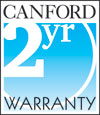
The commitment to quality and reliability is demonstrated by the two-year guarantee on all Canford manufactured products. Reliability comes from attention to detail during the design and manufacturing processes and comprehensive testing of the finished product. Pride is taken in the virtually zero returns rate and it is a measure of the success of the manufacturing and distribution operation that Canford manufactured products are to be found in over 50 countries of the world (at the last count).